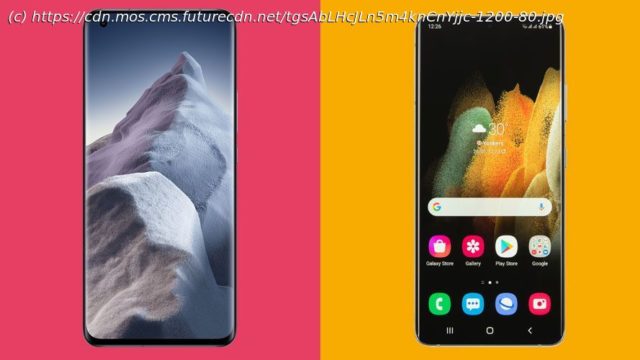It’s a genuine clash of the titans as two of the biggest, most expensive, and most extravagantly specced smartphones go head to head
The Xiaomi Mi 11 Ultra and the Samsung Galaxy S21 Ultra represent a new breed of smartphone opulence, offering top notch specs, extensive camera systems, and a maximalist design for a sky high price tag. But which phone offers the more premium experience? Which is the more balanced and usable phone day to day? And which would we spend our own money on, given the choice? Let’s take a closer look at these two luxury yachts of the Android smartphone scene. The Samsung Galaxy S21 Ultra arrived earlier in the year on January 29, 2021. It’s not cheap, with prices starting from $1,199 / £1,149 / AU$1,849 for the 128GB model. Upgrading to 256GB will set you back $1,249 / £1,199 / AU$1,949. There’s also a 512GB model, but it seems trickier to locate these days. The Xiaomi Mi 11 Ultra landed several months later than the Samsung, on April 2, 2021. It costs £1,199 / AU$1,799 (around $1,600) for 256GB of storage. As our estimate suggests, Xiaomi doesn’t sell its mainline phones in the US. We’re looking at two super-phones of roughly equivalent value, then. These are also two of the most expensive phones on the market. In our review we referred to the Xiaomi Mi 11 Ultra as “a parody of the Samsung Galaxy S21 Ultra,” largely thanks to its ludicrously indulgent design. It has a huge body which proves hard to fit into pockets. And we mean that quite literally – our reviewer found themselves resorting to carrying it in their backpack because it just didn’t fit in certain pairs of jeans. This isn’t really down to the height and width of the phone. While it’s certainly large at 164.3 x 74.6mm, this actually makes it slightly smaller than the 165.1 x 75.6mm Galaxy S21 Ultra What it all comes down to is the Mi 11 Ultra’s ginormous camera module. While the phone is listed as a fairly svelte 8.4mm thick overall – that’s half a millimetre thinner than the Galaxy S21 Ultra, incidentally – we’d guess that the camera module pushes it past the 10mm mark. This camera module isn’t just thick, either, but also spreads almost the entire width of the ceramic rear panel (which comes in Cosmic White or Cosmic Black). This pronounced apendage is left totally exposed even when the bundled case is used, so prepare for plenty of nicks and bumps unless you’re particularly careful. Both of these phones are unusually weighty, but the Xiaomi Mi 11 Ultra comes in heavier at 234g versus the Galaxy S21 Ultra’s 228g. We much prefer the Samsung Galaxy S21 Ultra’s design overall. You can also get it in a wider range of colors: Phantom Silver, Phantom Titanium, Phantom Navy, and Phantom Brown. Regardless of color, it’s a largely seamless design. Samsung’s solution to having such a pronounced camera module – and it’s still very big on its own terms – is far more elegant than Xiaomi’s, with a striking swoop integrating it into the metal chassis of the phone. Both phones go with subtly curved displays, which successfully split the difference between looks and function. The Samsung goes a little flatter, and has a slightly smaller screen to body ratio as a result. Both phones have an IP68 rating too, so they’re equally water and dust tight. These are two very similar displays, and they’re also among the very best on the market. The Xiaomi Mi 11 Ultra has a 6.81-inch 120Hz AMOLED display with a 1440 x 3200 resolution, both of which can be reached simultaneously. The Galaxy S21 Ultra has a 6.8-inch AMOLED display that’s also capable of running at a 120Hz refresh rate and at a Quad HD resolution at the same time. In fact, just about the only real edge that we can see belongs to the Xiaomi Mi 11 Ultra, which can get to 1700 nits of brightness maxed out. The Samsung Galaxy S21 Ultra ‘only’ gets to 1500 nits. ‘Only’ is a silly word to use here, though, because both of these screens get ridiculously bright.






